Capital Airport Express
The Capital Airport Express[1] of the Beijing Subway (Chinese: 北京地铁首都机场线[1]; pinyin: Běijīng Dìtiě Shǒudū Jīchǎng Xiàn), also known by the initials ABC, Airport Beijing City, is an airport rail link from Dongzhimen station to the Beijing Capital International Airport.[3] The line became operational on July 19, 2008. On subway maps, the Capital Airport Express' color is magnolia.
| Capital Airport Express[1] | ||||||||||||||||||||||||||||||||||||||||||||||||||||||||||||||||||||||||||||||||||||||||||||||||||||||||||||||||||||||||||||||||||||||||||||||||||||||||||||||||||||||||||||||||||||||||||||||||||||||||||||||||||||||||||||||||||||||
|---|---|---|---|---|---|---|---|---|---|---|---|---|---|---|---|---|---|---|---|---|---|---|---|---|---|---|---|---|---|---|---|---|---|---|---|---|---|---|---|---|---|---|---|---|---|---|---|---|---|---|---|---|---|---|---|---|---|---|---|---|---|---|---|---|---|---|---|---|---|---|---|---|---|---|---|---|---|---|---|---|---|---|---|---|---|---|---|---|---|---|---|---|---|---|---|---|---|---|---|---|---|---|---|---|---|---|---|---|---|---|---|---|---|---|---|---|---|---|---|---|---|---|---|---|---|---|---|---|---|---|---|---|---|---|---|---|---|---|---|---|---|---|---|---|---|---|---|---|---|---|---|---|---|---|---|---|---|---|---|---|---|---|---|---|---|---|---|---|---|---|---|---|---|---|---|---|---|---|---|---|---|---|---|---|---|---|---|---|---|---|---|---|---|---|---|---|---|---|---|---|---|---|---|---|---|---|---|---|---|---|---|---|---|---|---|---|---|---|---|---|---|---|---|---|---|---|---|---|---|---|
| Capital Airport | ||||||||||||||||||||||||||||||||||||||||||||||||||||||||||||||||||||||||||||||||||||||||||||||||||||||||||||||||||||||||||||||||||||||||||||||||||||||||||||||||||||||||||||||||||||||||||||||||||||||||||||||||||||||||||||||||||||||
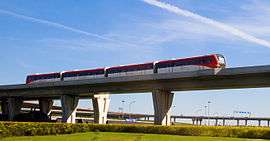 | ||||||||||||||||||||||||||||||||||||||||||||||||||||||||||||||||||||||||||||||||||||||||||||||||||||||||||||||||||||||||||||||||||||||||||||||||||||||||||||||||||||||||||||||||||||||||||||||||||||||||||||||||||||||||||||||||||||||
| Overview | ||||||||||||||||||||||||||||||||||||||||||||||||||||||||||||||||||||||||||||||||||||||||||||||||||||||||||||||||||||||||||||||||||||||||||||||||||||||||||||||||||||||||||||||||||||||||||||||||||||||||||||||||||||||||||||||||||||||
| Other name(s) | L1 (planned name) | |||||||||||||||||||||||||||||||||||||||||||||||||||||||||||||||||||||||||||||||||||||||||||||||||||||||||||||||||||||||||||||||||||||||||||||||||||||||||||||||||||||||||||||||||||||||||||||||||||||||||||||||||||||||||||||||||||||
| Type | Airport rail link | |||||||||||||||||||||||||||||||||||||||||||||||||||||||||||||||||||||||||||||||||||||||||||||||||||||||||||||||||||||||||||||||||||||||||||||||||||||||||||||||||||||||||||||||||||||||||||||||||||||||||||||||||||||||||||||||||||||
| System | Beijing Subway | |||||||||||||||||||||||||||||||||||||||||||||||||||||||||||||||||||||||||||||||||||||||||||||||||||||||||||||||||||||||||||||||||||||||||||||||||||||||||||||||||||||||||||||||||||||||||||||||||||||||||||||||||||||||||||||||||||||
| Status | Operational | |||||||||||||||||||||||||||||||||||||||||||||||||||||||||||||||||||||||||||||||||||||||||||||||||||||||||||||||||||||||||||||||||||||||||||||||||||||||||||||||||||||||||||||||||||||||||||||||||||||||||||||||||||||||||||||||||||||
| Locale | Dongcheng, Chaoyang, and Shunyi districts Beijing | |||||||||||||||||||||||||||||||||||||||||||||||||||||||||||||||||||||||||||||||||||||||||||||||||||||||||||||||||||||||||||||||||||||||||||||||||||||||||||||||||||||||||||||||||||||||||||||||||||||||||||||||||||||||||||||||||||||
| Termini | Terminal 3 / Terminal 2 Dongzhimen | |||||||||||||||||||||||||||||||||||||||||||||||||||||||||||||||||||||||||||||||||||||||||||||||||||||||||||||||||||||||||||||||||||||||||||||||||||||||||||||||||||||||||||||||||||||||||||||||||||||||||||||||||||||||||||||||||||||
| Stations | 4 | |||||||||||||||||||||||||||||||||||||||||||||||||||||||||||||||||||||||||||||||||||||||||||||||||||||||||||||||||||||||||||||||||||||||||||||||||||||||||||||||||||||||||||||||||||||||||||||||||||||||||||||||||||||||||||||||||||||
| Daily ridership | 31,300 (2014 Avg.) 49,100 (2014 Peak)[2] | |||||||||||||||||||||||||||||||||||||||||||||||||||||||||||||||||||||||||||||||||||||||||||||||||||||||||||||||||||||||||||||||||||||||||||||||||||||||||||||||||||||||||||||||||||||||||||||||||||||||||||||||||||||||||||||||||||||
| Operation | ||||||||||||||||||||||||||||||||||||||||||||||||||||||||||||||||||||||||||||||||||||||||||||||||||||||||||||||||||||||||||||||||||||||||||||||||||||||||||||||||||||||||||||||||||||||||||||||||||||||||||||||||||||||||||||||||||||||
| Operator(s) | Beijing Capital Metro Corp., Ltd. | |||||||||||||||||||||||||||||||||||||||||||||||||||||||||||||||||||||||||||||||||||||||||||||||||||||||||||||||||||||||||||||||||||||||||||||||||||||||||||||||||||||||||||||||||||||||||||||||||||||||||||||||||||||||||||||||||||||
| Depot(s) | Tianzhu | |||||||||||||||||||||||||||||||||||||||||||||||||||||||||||||||||||||||||||||||||||||||||||||||||||||||||||||||||||||||||||||||||||||||||||||||||||||||||||||||||||||||||||||||||||||||||||||||||||||||||||||||||||||||||||||||||||||
| Rolling stock | 4-car Type LB (QKZ5) | |||||||||||||||||||||||||||||||||||||||||||||||||||||||||||||||||||||||||||||||||||||||||||||||||||||||||||||||||||||||||||||||||||||||||||||||||||||||||||||||||||||||||||||||||||||||||||||||||||||||||||||||||||||||||||||||||||||
| Technical | ||||||||||||||||||||||||||||||||||||||||||||||||||||||||||||||||||||||||||||||||||||||||||||||||||||||||||||||||||||||||||||||||||||||||||||||||||||||||||||||||||||||||||||||||||||||||||||||||||||||||||||||||||||||||||||||||||||||
| Line length | 28.1 kilometres (17.5 mi) | |||||||||||||||||||||||||||||||||||||||||||||||||||||||||||||||||||||||||||||||||||||||||||||||||||||||||||||||||||||||||||||||||||||||||||||||||||||||||||||||||||||||||||||||||||||||||||||||||||||||||||||||||||||||||||||||||||||
| Track gauge | 1,435 mm (4 ft 8 1⁄2 in) | |||||||||||||||||||||||||||||||||||||||||||||||||||||||||||||||||||||||||||||||||||||||||||||||||||||||||||||||||||||||||||||||||||||||||||||||||||||||||||||||||||||||||||||||||||||||||||||||||||||||||||||||||||||||||||||||||||||
| Operating speed | 110 km/h | |||||||||||||||||||||||||||||||||||||||||||||||||||||||||||||||||||||||||||||||||||||||||||||||||||||||||||||||||||||||||||||||||||||||||||||||||||||||||||||||||||||||||||||||||||||||||||||||||||||||||||||||||||||||||||||||||||||
| ||||||||||||||||||||||||||||||||||||||||||||||||||||||||||||||||||||||||||||||||||||||||||||||||||||||||||||||||||||||||||||||||||||||||||||||||||||||||||||||||||||||||||||||||||||||||||||||||||||||||||||||||||||||||||||||||||||||
| Capital Airport Express | |||||||
|---|---|---|---|---|---|---|---|
| Simplified Chinese | 北京地铁首都机场线 | ||||||
| Traditional Chinese | 北京地鐵首都機場線 | ||||||
| |||||||
Overview
The Capital Airport Express is currently 28.1 kilometres (17.5 mi) in length and has four stations: Dongzhimen and Sanyuanqiao in the city, and two stations in the Beijing Capital International Airport, one at Terminal 3, and the other at Terminal 2. Trains departing Dongzhimen first stop at Sanyuanqiao, then proceed to the airport and serve Terminal 3. Here, they reverse direction and proceed to Terminal 2, where they reverse out again and head back to Dongzhimen via Sanyuanqiao. There is no station serving Terminal 1 directly; riders must alight at Terminal 2 and use a walkway to reach Terminal 1.
Like other subway lines in Beijing, the entire line is grade separated from traffic. Most of the track is at ground level or elevated, paralleling the S12 Airport Expressway, with several underpasses crossing underneath existing railway lines. However, the 4 kilometres (2.5 mi) section between Dongzhimen and Sanyuanqiao is underground, and the line near Terminal 2 is also underground.
A one-way fare on the Capital Airport Express costs RMB(¥) 25, with no free transfers from other lines.[4] Unlike similar rail services such as the MTR Airport Express in Hong Kong and the Taoyuan Airport MRT in Taiwan, there is no downtown check-in at Dongzhimen or Sanyuanqiao stations. While there are reserved storage spaces for heavy luggage on board the trains, taking them on board regular subway lines to and from the Capital Airport Express is not advised as the trains are very crowded.
Stations
| Service routes |
Station Name | Connections | Nearby Bus Stops | Distance km[5] |
Location | |||
|---|---|---|---|---|---|---|---|---|
| English | Chinese | |||||||
| Beixinqiao | 北新桥 | 5 | Dongcheng | |||||
| ● | ● | Dongzhimen | 东直门 | 2 13 | 3 18 24 44 75 106 107 117 123 130 132 359 401 404 413 416 418 612 635 850 850快 852 915 915快 916 916快 918 935 935快 942快 966 980 980快 特2 特12 夜6 夜10 夜20 夜32 | 0.000 | 0.000 | |
| ● | ● | Sanyuanqiao | 三元桥 | 10 | 18 95 104 132 300 300快 302 359 379 401 403 404 419 536 604 641 671 847 850 850快 852 915 915快 916 916快 918 935 935快 939 980 980快 985 特8 夜18 夜30 | 3.022 | 3.022 | Chaoyang |
| ● | ↑ | Terminal 3 | 3号航站楼 | 18.322 | 21.344 | Shunyi | ||
| ↳ | ● | Terminal 2 | 2号航站楼 | 7.243 | 28.587 | Chaoyang | ||
History
The Airport Express was originally conceived to run non-stop between Dongzhimen and the Capital Airport. An intermediate stop at Sanyuanqiao was subsequently added for the convenience of passengers connecting to Line 10.[6][7]
Designers for the new line considered several types of technology for the Airport Express, including:
- high-speed maglev, similar to that of the Shanghai Maglev Train
- low-speed maglev, similar to that of the Linimo line in Japan
- conventional electric motor propulsion
- linear motor propulsion
The linear motor option was ultimately decided upon.[6][8]
Planning accelerated after the city won the bid to host the 2008 Summer Olympic Games, which included a promise to connect the airport to the Olympic village by subway.[6] The project cost ¥5.4bn and involved a consortium of companies led by the Beijing Dongzhimen Airport Express Rail Company.[9]
The project operated under a tight delivery schedule, initially with very limited public disclosure.[9][10] During construction, officials from both the Beijing Dongzhimen Airport Express Rail Co. and Bombardier expressed concerns about whether the project would be completed, as originally planned, by the end of 2007, with test operations to start in April 2008.[10] At the time, Zhang Jianwei, chief country representative for Bombardier, called the short timetable for a project of this type unprecedented. Zhang expressed confidence that Bombardier would meet its responsibilities as its Chinese contractors routinely worked 24 hours a day, something not possible in other countries. He also noted, however, that even if the line were to open on time, the need for haste could compromise the quality of construction.[10]
There was also considerable uncertainty over the progress of the project, the identity of contractors and its operational arrangement. Construction was reported to have begun on June 14, 2005, but aspects of the project still awaited the central government's approval.[11] Local media reported in January 2005 that the train supplier had been “basically decided”, but was not officially selected and announced until March 2006.[10]
Track-laying began in March 2007 and was completed by November 2007.[12] Testing using empty trains commenced in April 2008 and official operations started on July 19 of that year, in time for the opening of the Summer Olympic Games on August 8, 2008.[13][14] The line delivered 2.17 million rides in 2008.[15]
| Segment | Commencement | Length | Station(s) | Name |
|---|---|---|---|---|
| Dongzhimen — Terminal 3/Terminal 2 | 19 July 2008 | 28.1 km (17.46 mi) | 4 | Capital Airport Express (initial phase) |
Service
The Airport Express runs 7 days a week. The first airport-bound train of the day departs from Dongzhimen at 6:00 and from Sanyuanqiao at 6:04, and arrives at Terminal 3 at 6:21 and at Terminal 2 at 6:35. The train then becomes the first city-bound train, returning to Sanyuanqiao at 6:52 and to Dongzhimen at 6:56.[16] The last airport-bound train of the day departs from Dongzhimen at 22:30 and from Sanyuanqiao at 22:34, and arrives at Terminal 3 at 22:51 and at Terminal 2 at 23:10. It becomes the last city-bound train, returning to Sanyuanqiao at 23:27 and to Dongzhimen at 23:31.[16]
From Dongzhimen, the trip to Terminal 3 takes 16 minutes and to Terminal 2 takes 35 minutes.[16] From the airport, the trip from Terminal 2 to Dongzhimen takes 21 minutes and from Terminal 3 takes 30 minutes including a 5-minute stop at Terminal 2.[16] Trains depart every 8.5 minutes during peak hours and every 10 minutes during off-peak hours.[17] The Airport Express is generally faster and more frequent than the Beijing Airport Bus (trains typically depart every 10 minutes compared to 30 minutes for the bus), but is more expensive (the bus service costs ¥16) and departs more frequently. The train, though, are cheaper than taxis, which cost around ¥80 between the airport and Dongzhimen.
As currently configured, the Airport Express line is designed to carry up to 4,500 passengers per hour at peak times and 40,000 passengers a day, with trains running for 15 hours a day with a minimum separation of four minutes between trains.[9][18] This level is insufficient to cope with the rapidly growing numbers of passengers using the airport, which ranks second globally in terms of number of passengers served, with 81.6 million passengers in 2012. By 2015, this was forecasted to exceed 90 million.[19]
In April 2012, daily ridership on the Airport Express line was reported as 36,800.[2] This is 18 percent of the average daily number of airport passengers, but this percentage is likely to decline as ridership on the line during peak hours is already close to the design maximum.[9]
Infrastructure and rolling stock
The Airport Express line adopts Advanced Rapid Transit (since renamed Innovia Metro) technology from Bombardier Transportation, with a fleet of 40 QKZ5 trains assembled by Changchun Railway Vehicles (CRV, now part of CRRC Corporation) under a technology transfer agreement.[20] The vehicles were based off those used on AirTrain JFK in New York City, with Bombardier providing bogies as well as the electrical, propulsion and brake systems, which were assembled by CRV.
As with the majority of Beijing Subway trains, the Airport Express trains use a 750 V third rail power supply, and have a maximum speed of 100 kilometers per hour. Trains are configured in fixed sets of four cars with a total of 230 seats, arranged in a longitudinal layout to maximize their quantity.
The line uses Alstom's "Urbalis" communications-based train control system, which is capable of driving trains automatically, although staff still monitor the trains from the front (Grade of Automation level 2).[21] At the time of opening, this system made the Airport Express the first rapid transit line with automated operation in China, and the second such rail line of any kind, after the people mover in Terminal 3 at the airport, which was also supplied by Bombardier.[10]
Future Development
Western extension to Beixinqiao
An 1.9-kilometre (1.2 mi) extension to Beixinqiao, which would provide an interchange with Line 5, is expected to enter operation in 2021.[22][23]
Others
In the short term, there is little scope to increase the Airport Express line's capacity. The 4-car train sets used on the line have significantly lower capacity than those on other Beijing subway lines, which operate 6-car or 8-car train sets[24] [25]. Also, the Airport Express track design requires trains from Terminal 3 to first travel to Terminal 2 before returning to the city. If trains were able to return directly from Terminal 3 to the city the capacity on the route could be increased.
Reserved space for an infill station at Wangjing South, where the Airport Express intersects with Line 14, is also part of long-term plans.[26]
Rolling Stock
| Model | Image | Manufacturer | Year Built | Amount in Service | Fleet Numbers | Depot |
|---|---|---|---|---|---|---|
| QKZ5 | CRRC Changchun Railway Vehicles Bombardier Transportation |
2007 | 10 | L1 101-L1 110 | Tianzhu |
Gallery
| Wikimedia Commons has media related to Capital Airport Express, Beijing Subway. |
- Capital Airport Express of Beijing Subway
 Fare card showing sequence of stops
Fare card showing sequence of stops- The Airport Express at Terminal 3
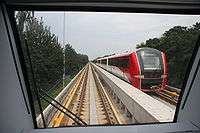 Bombardier MK II cars on the Airport Express.
Bombardier MK II cars on the Airport Express.- Approach to Terminal 3
- Entering Terminal 3.
 Airport Express entrance at Terminal 2
Airport Express entrance at Terminal 2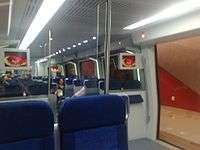 Inside Airport Express train
Inside Airport Express train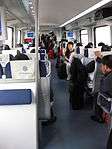 Aboard the train.
Aboard the train.- Sanyuanqiao Station entrance
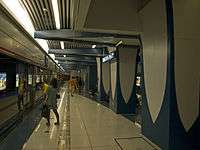 Airport Express platform at Sanyuanqiao Station
Airport Express platform at Sanyuanqiao Station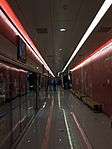 Dongzhimen Station platform
Dongzhimen Station platform
See also
- Daxing Airport Express of Beijing Subway
- Beijing Airport Bus
References
- "改名了!机场线更名为首都机场线". 2019-09-24.
- (Chinese) Retrieved 2012-04-28 "北京地铁昨天全路网日客运量首破800万高达839.1万人次". Beijing Subway Corporation. 2012-04-28.
- 地铁机场线今日开通 最大时速110公里用男乘务员 (in Chinese). Xinhua News. 2008-07-19.
- "Express Railway" BCIA.com Accessed 2014-06-05
- "首都机场线路网车站站间距信息". Retrieved 2020-04-29.
- (Chinese) "全线运营点对点不建磁悬浮 机场轨道明年动工" 北京青年报 2003-12-14 [2012-08-25.
- 北京机场轨道线再掀面纱 地下通道与十号线连接. 2005-03-25 [2012-08-25].
- 5.0 5.1 北京市市政工程设计研究总院 北京市勘察设计研究院有限公司本卷主编.. 《再塑北京——市政与交通工程》. Beijing: 中国建筑工业出版社 [China Architectural and Industrial Press]. 2008. pp. 141-157. ISBN 978-7-112-09885-9.
- "Beijing Olympic Village Rail Link Construction, China" Railway-Technology.com. Retrieved [2012-12-29
- Mure Dickie, "Fears over Beijing Olympic rail link" Financial Times 2006-08-18 Retrieved [2012-12-29]
- 首都机场快速轨道首站开建 9月1日全线开工. 2005-06-15 [2012-08-25].
- "Track laying completed for Beijing Subway Airport Line" The Official Website of the Beijing 2008 Olympic Games Archived 2009-02-03 at the Wayback Machine
- 首都机场轨道线试运行 市区18分钟内可达机场. 2008-04-27 [2012-08-25].
- 北京地铁周末“三线齐发” 机场线票价尚未公布. 2008-07-18 [2012-08-25].
- 北京地铁2008年运送乘客突破12亿人次 (in Chinese). Beijing Morning News. 2009-01-02.
- (Chinese) 机场线首末车时刻表 (Schedule of the First and Last Airport Express Trains) Accessed 2014-04-13
- 6月10日起机场线最小列车间隔缩短为8分30秒. 北京市地铁运营有限公司. 2012-06-07 [2012-08-25].
- 首都机场轨道线开始铺轨 2008年7月将载客运营. 2007-03-02 [2012-08-25].
- "80 million fly through airport", China Daily 2012-12-27.
- "Bombardier Awarded Contract in China for the Beijing Capital International Airport Link With Connection to Summer 2008 Olympic Games Village" Business Wire Mar. 20, 2006
- ^ 北京机场线将建无人驾驶地铁. 2006-08-08 [2012-08-25].
- "16号线中段今年有望开通". 2020-01-12.
预计2021年底机场线西延实现通车 (The western extension of Capital Airport Express will open in 2021)
- http://www.xinhuanet.com/politics/2018-04/18/c_1122698300.htm
- ^ a b "Linear Motor Commuter for Beijing" CNR website Accessed Mar. 27, 2010
- "4条地铁线将装屏蔽门 (in Chinese). 法制晚报. 2010-01-20.
- http://epaper.ynet.com/html/2014-07/10/content_72348.htm?div=-1
External links
- Beijing Capital International Airport: Airport Traffic
- Beijing Airport Express Train Schedule
- Beijing Capital Metro Co., Ltd. official website (can only be accessed by internal accounts)